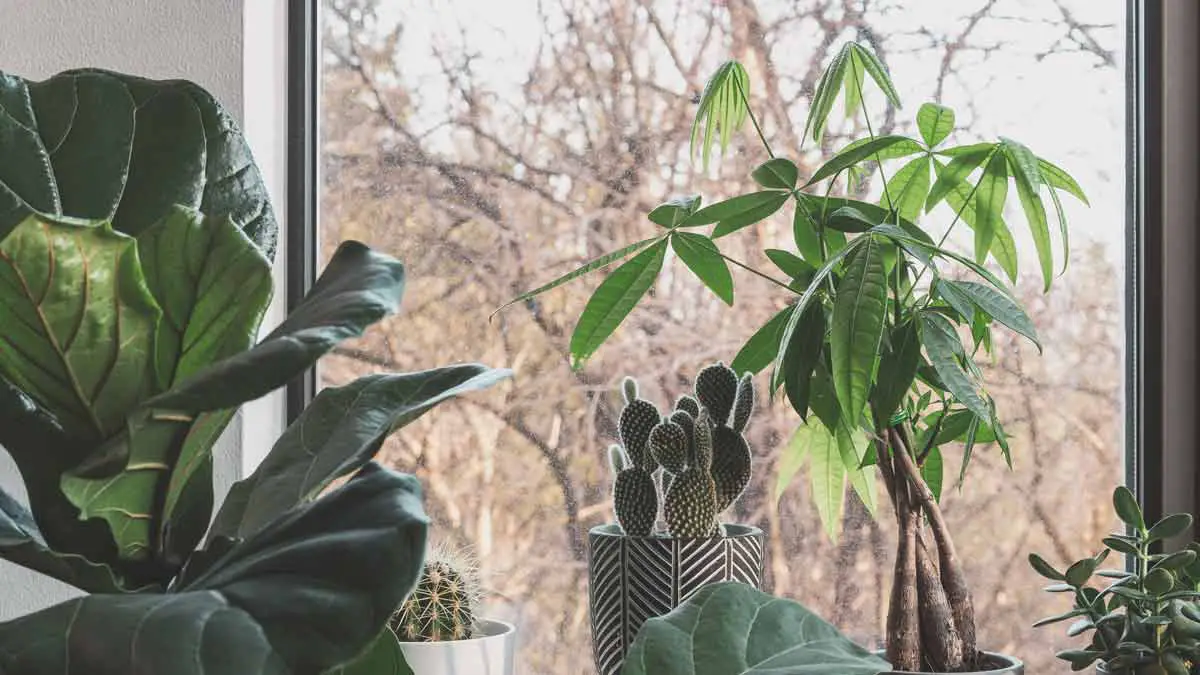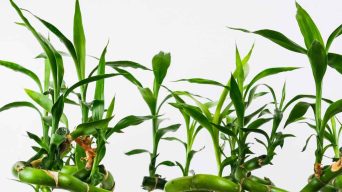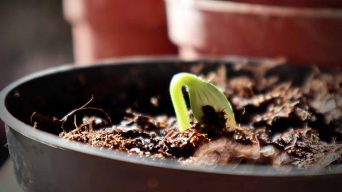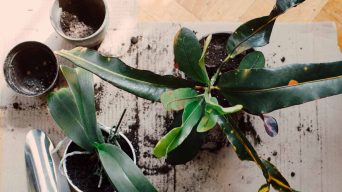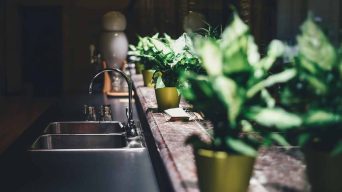To promote faster indoor plant growth, ensure proper lighting, ideal temperature and humidity, controlled watering, balanced fertilization, occasional pruning, well-draining soil, pest/disease vigilance, and consistent care routines. These steps enhance indoor plant growth.
Is your fern feeling fickle? Your succulent seeming sad? In our increasingly urbanized, indoor world of 2023, cultivating a robust jungle at home has become more than just a hobby – it’s a lifestyle!
But all too often, our green companions can take their sweet time to flourish.
In this enlightening blog post, we’ll investigate the top tips and inventive techniques to help indoor plants thrive faster.
Whether you’re eager for that fiddle leaf fig to fill the room or quicken the pace of your pilea’s growth, our guide promises a greener home in less time.
A paradise isn’t crafted overnight, but with these expert insights, it doesn’t have to be a wait of seasons, either!
Facts and Statistics
- According to the National Gardening Association, providing indoor plants with light in the correct spectrums can boost their growth rates by up to 40%.
- The Virginia Cooperative Extension reports that maintaining temperatures between 65 and 75°F can optimize photosynthesis in most common houseplants and promote faster growth.
- A 2020 study in the Journal of Plant Physiology found that optimal watering – neither too little nor too much – can enhance plant growth by as much as 50%.
Optimizing Indoor Environment for Plant Growth
Creating an optimal environment for your indoor plants is crucial for promoting their growth and overall health.
Taking a holistic approach by considering factors such as lighting, temperature, humidity, and air circulation can significantly enhance the success of your indoor gardening endeavors.
Providing Adequate Light
Proper lighting is one of the most essential elements for indoor plant growth.
Just like their outdoor counterparts, plants need light for photosynthesis, the process by which they convert light energy into chemical energy to fuel their growth. Insufficient light can lead to weak, spindly growth and a lack of flowering or fruit production.
Regarding lighting, there are two main options: natural light and artificial grow lights. Most indoor plants thrive in bright, indirect light conditions.
Place your plants near a south-facing window where they can receive ample sunlight throughout the day. East or west-facing windows can provide sufficient light, but be mindful of potential hot spots that could scorch your plants.
Imagine placing a vibrant pothos plant on a windowsill bathed in gentle morning sunlight. The leaves bask in the warm glow as they soak up the necessary energy for rapid growth and abundant foliage.
However, not all homes offer adequate natural light for optimal plant growth. In such cases, artificial grow lights are a great alternative.
LED grow lights have become increasingly popular due to their energy efficiency and customizable spectrums catering to different plant growth stages. These lights emit the specific wavelengths of light that plants require for photosynthesis.
Lighting Options for Indoor Plants:
| Natural Light | Artificial Grow Lights |
|---|---|
| South-facing windows | LED grow lights |
| East or west-facing windows | Fluorescent grow lights |
| Skylights | High-intensity discharge (HID) grow lights |
Investing in a quality grow light system helps ensure your plants receive the necessary light for healthy growth. Position the lights at an appropriate distance from your plants, usually around 6-12 inches, to prevent burning or stretching.
Remember, different plants have varying light requirements. While some thrive in bright, indirect light, others prefer lower light conditions. Research the specific needs of your plant species to provide them with the right amount and quality of light.
Proper Temperature and Humidity
Proper temperature and humidity levels play a vital role in the growth and development of indoor plants. Just like humans, plants have their own preferences when it comes to environmental conditions.
Maintaining optimal temperature and humidity creates an ideal atmosphere for plant growth.
Most indoor plants thrive in temperatures between 65-75°F (18-24°C). This range provides a comfortable environment where plants can carry out essential metabolic processes efficiently.
However, some plants may have slightly different temperature requirements, so it’s important to research the specific needs of each species you are cultivating.
For instance, tropical plants such as orchids or ferns prefer higher humidity levels compared to succulents.
These moisture-loving plants generally thrive in environments with humidity levels around 60-80%. On the other hand, desert plants like cacti prefer lower humidity levels, closer to 40-50%.
| Plant Type | Temperature Range | Humidity Range |
|---|---|---|
| Tropical Plants | 65-75°F (18-24°C) | 60-80% |
| Succulents | 65-75°F (18-24°C) | 40-50% |
| Desert Plants | 65-75°F (18-24°C) | 30-40% |
Techniques to Stimulate Indoor Plant Growth
Achieving faster growth in indoor plants requires more than just providing basic care.
Here are several techniques you can incorporate into your plant care routine to stimulate growth:
- Pruning and Trimming: Regularly pruning your indoor plants helps remove dead or yellow leaves, promotes new growth, and maintains their shape. Trimming overgrown branches or stems redirects the plant’s energy towards developing new foliage.
- Optimal Lighting: Adequate light is crucial for photosynthesis and overall plant growth. Place your plants near a south-facing window to maximize natural sunlight exposure. Consider using grow lights specifically designed for indoor plants if lighting conditions are insufficient.
- Balanced Fertilization: Regularly applying a balanced fertilizer provides essential nutrients necessary for healthy plant growth. Follow the instructions on the fertilizer packaging to avoid over-fertilization and potential damage to your plants.
- Well-Draining Potting Soil: Growing plants in well-draining potting soil creates an optimal root environment by allowing proper air circulation and preventing waterlogging. This ensures that roots have access to oxygen, which is crucial for nutrient absorption.
- Plant Growth-Promoting Products: Consider using organic products like seaweed extract or compost tea, which can enhance the growth of indoor plants. These products provide additional nutrients, promote root development, and improve overall plant vigor.
For example, using a diluted solution of seaweed extract as a foliar spray can stimulate plant growth and increase resistance to stressors.
| Technique | Benefits |
|---|---|
| Pruning and Trimming | Promotes new growth, maintains shape |
| Optimal Lighting | Maximizes photosynthesis and overall plant growth |
| Balanced Fertilization | Provides essential nutrients for healthy growth |
| Well-Draining Potting Soil | Promotes proper air circulation and prevents waterlogging |
| Plant Growth-Promoting Products | Enhances growth through additional nutrients and improved root development |
By implementing these techniques and understanding the specific needs of your indoor plants, you can provide an optimal environment for their growth and witness remarkable improvements in their development.
Regular Fertilization and Watering
Proper fertilization and watering are key factors in promoting the fast growth of indoor plants. Just like humans need essential nutrients to thrive, plants also rely on a balanced diet to support their growth.
Regular fertilization provides necessary nutrients that might be lacking in the soil, stimulating plant growth and overall health.
The type and frequency of fertilization depend on the plant species, its growth stage, and the fertilizer used.
Generally, using a balanced fertilizer with equal amounts of nitrogen (N), phosphorus (P), and potassium (K) can provide the necessary nutrients for optimal growth.
It’s important to follow the instructions on the fertilizer packaging for proper application rates and timing.
When it comes to watering, finding the right balance is crucial. While water is vital for plant growth, overwatering can lead to root rot and hinder growth.
Before watering your plants, check the soil’s moisture level by inserting your finger about an inch deep into the soil. If it feels dry at that depth, it’s time to water.
However, if it feels moist or damp, hold off on watering until it dries out a bit.
Keep in mind that different plants have varying water needs based on factors such as their size, type, and environment.
Plants that prefer drier conditions, like succulents or cacti, require infrequent but thorough watering. On the other hand, tropical plants tend to thrive in slightly more humid environments and may require more frequent watering.
For instance, let’s consider a vibrant Money Tree (Pachira aquatica) that you have in your living room. This particular plant benefits from regular fertilization with a balanced liquid houseplant fertilizer every month during spring and summer when it’s actively growing.
As for watering, allow the top inch of soil to dry out between each watering session to prevent waterlogging.
Remember, paying attention to the specific needs of your plants is crucial. By providing adequate fertilization and watering, you are helping to create an environment that can foster faster and healthier growth.
Now that we have covered the importance of regular fertilization and watering let’s move on to another essential technique for facilitating fast plant growth – effective pruning methods.
Effective Pruning Methods
Pruning is a vital technique that can significantly influence the growth and shape of indoor plants.
By selectively removing certain parts of the plant such as branches, stems, or leaves, you can stimulate new growth and maintain your plant’s desirable shape.
One important aspect of pruning is removing dead or yellow leaves. These leaves no longer contribute to the plant’s health and can drain its energy reserves.
Additionally, removing dead or diseased foliage helps prevent the spread of pests or diseases throughout the plant.
Another pruning method involves trimming overgrown branches or stems. This not only keeps your plant within desired size limits but also encourages new growth from the trimmed areas.
Remember to use sharp and clean pruning shears to make precise cuts without causing unnecessary damage to the plant.
Let’s consider a lush Monstera (Monstera deliciosa) with sprawling vines covering a trellis in your study room. Regularly pruning any excessively long vines or aerial roots can help redirect energy toward new growth points while maintaining a compact and aesthetically pleasing shape.
Keep in mind that each plant has its own specific pruning requirements and techniques.
It is important to research individual plant species to understand their unique needs and best practices for effective pruning.
As you gain experience with different plants, you’ll become more comfortable identifying when and where pruning is necessary.
Think of pruning as a gardener sculpting a masterpiece out of clay – carefully shaping and trimming to bring out the full potential of the art form.
With a solid understanding of regular fertilization, watering, and effective pruning methods, we can now explore another crucial aspect that impacts the growth of indoor plants – the significance of soil and potting choices.
Importance of Soil and Potting for Fast Growth
When it comes to maximizing the growth potential of your indoor plants, the importance of soil and potting cannot be overstated.
The right soil composition and proper potting techniques provide a solid foundation for fast growth and overall plant health.
First and foremost, it is crucial to use well-draining potting soil that allows for adequate air circulation and prevents waterlogging.
Plants need oxygen at their roots for optimal growth, and overly compacted or waterlogged soil can suffocate them.
Look for potting mixes specifically formulated for indoor plants, as they often contain a mix of organic matter like peat moss or coconut coir, which helps retain moisture while allowing for drainage.
Additionally, consider adding amendments like perlite or vermiculite to your potting mix. These materials help improve soil structure, enhance drainage, and increase aeration.
Creating a loose and friable texture promotes root development and nutrient uptake.
When repotting your plants, ensure you choose pots that are appropriate in size.
A pot that is too large for your plant’s root system can lead to excessive moisture retention, while one that is too small may restrict root growth. Select pots with drainage holes at the bottom to allow excess water to escape easily.
Picture this: You have a beautiful Monstera plant that you’ve been nurturing for some time. However, despite providing it with sufficient light and regular watering, you notice slow growth and lackluster foliage development.
Upon closer inspection, you discover it has been sitting in a pot without drainage holes, trapping water around the roots.
By transplanting it into a well-draining pot with suitable soil composition, you create an environment conducive to faster growth.
Soon enough, your Monstera flourishes with vibrant leaves unfurling before your eyes.
Remember to keep an eye on the soil’s moisture level, as overwatering can lead to root rot and hinder growth. Use your finger or a moisture meter to check if the soil is dry before watering again.
Water thoroughly until it drains out of the bottom, allowing excess water to be flushed out, but avoid leaving the plant sitting in standing water.
While proper soil and potting provide an excellent foundation for fast plant growth, another crucial aspect is the prevention and handling of common houseplant pests.
Prevention and Handling of Common Houseplant Pests
As much as we’d like our indoor plants to be free from pests, unfortunately, these unwanted visitors can sometimes find their way into our homes.
Preventing and managing common houseplant pests is essential in maintaining healthy and robust growth.
One effective preventive measure is regular inspection of your plants. Take the time to examine both the foliage and the soil for any signs of infestation.
Look for telltale signs such as yellowing leaves, webs, tiny moving insects, or puckering on the foliage. The sooner you catch a pest problem, the easier it will be to address.
One natural method for pest prevention is keeping plants clean by regularly wiping down leaves with a damp cloth or gently rinsing them under lukewarm water. This removes dust and discourages pests from taking up residence on your plant.
Additionally, practicing good hygiene in your home can also play a significant role in preventing pests.
Avoid placing infested plants next to healthy ones, as pests can easily transfer from one plant to another. Inspect new plants before bringing them into your space as they may already have hidden pests.
If despite preventative measures you find yourself dealing with a pest infestation, there are several strategies you can employ.
First, try using insecticidal soap or neem oil spray—both effectively control a wide range of common pests like aphids, spider mites, mealybugs, and soil mites.
Follow the instructions on the product label for proper application and frequency.
Let’s say you discover mealybugs have invaded your beloved Peace Lily. These small, cottony white insects detract from the plant’s appearance and can affect its overall health.
By diligently treating the infestation with targeted sprays or by physically removing the pests using a cotton swab dipped in rubbing alcohol, you can regain control and help your Peace Lily thrive once again.
If chemical options aren’t your preference, many natural remedies can be effective against pests.
For example, sticky traps placed near plants can catch flying insects like fungus gnats, while introducing beneficial insects such as ladybugs or predatory mites can help control more persistent pests.
Final Thoughts
Cultivating a lush indoor garden is rewarding, and the quest for faster plant growth can be a fulfilling journey. With the right knowledge and techniques, you can turn your indoor space into a flourishing oasis.
Remember, creating an optimal environment for your indoor plants is the first step toward promoting growth. Adequate lighting, the right temperature, and suitable humidity levels are the foundation upon which your botanical masterpiece will thrive.
Implementing techniques like pruning and trimming, optimizing light exposure, balanced fertilization, and using well-draining potting soil can help your plants reach their full potential. By understanding your plants’ individual needs and nurturing them accordingly, you’re well on your way to a greener, more vibrant home.
Regular fertilization and proper watering are your plants’ daily nutrients to grow and flourish. The balanced approach ensures they receive the essential elements without the risk of overfeeding or overwatering.
Pruning, on the other hand, is like the sculptor’s chisel, helping you shape and refine your plant’s appearance while stimulating new growth. Each species has its unique pruning requirements, and learning these intricacies is key to success.
And last but not least, safeguard your indoor garden from common houseplant pests by practicing preventive measures and employing effective pest control methods when needed. A watchful eye and timely intervention can ensure your plants stay pest-free and continue to thrive.
With these insights and techniques in your horticultural toolkit, your indoor plant collection is destined for faster growth and stunning beauty. So, go ahead, nurture your urban jungle, and bask in the flourishing greenery of your indoor paradise.

